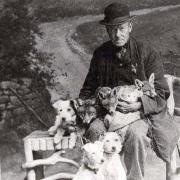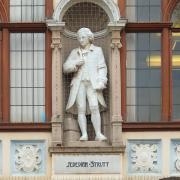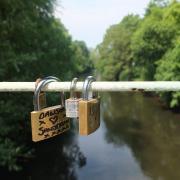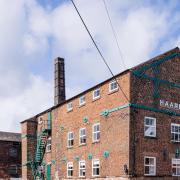It's 125 years since a Derbyshire charity first took children from Derby on holiday to Skegness. Pat Ashworth talks to Derbyshire Children's Holiday Centre chairman Bill Tomlinson about the plans to celebrate the anniversary

There’s a treasured little piece of Derbyshire in a quiet residential street just off the promenade in Skegness. Children from less fortunate backgrounds have been arriving for seaside holidays at the Derbyshire Children’s Holiday Centre (DCHC) since 1891, when the charity was set up by public subscription and a group of the City Fathers bought the land on which the house stands from the Earl of Scarbrough.
Back then, and for a long while after that, they’d have come by train. So there’ll be a very particular thrill on Sunday 25th September when, as part of the charity’s 125th anniversary celebrations, the first steam train to travel from Derby to Skegness since the 1950s will replicate that experience. On this occasion, as a giant fundraising event, it will be carrying 450 fare-paying passengers – including 200 in Pullman class with silver service. The Centre itself will be open to visitors that day.
The charity is thinking big because it has a big vision. It wants to help even more children, in a society today where the needs are acknowledged to be as great if not greater than when it was set up. It is currently able to give 450 holidays a year but receives annually in excess of 600 referrals: children in desperate need of a holiday, the majority identified by schools and social services. Many have suffered abuse and neglect: others come from loving, caring families who are simply currently experiencing difficult circumstances through no fault of their own.
‘Some things still shock me now, even after all this time,’ says Bill Tomlinson, who has been chairman of DCHC since 2002 and a trustee since 1984. He got involved when Rotary were fundraising for a brick-and-tile beach hut for the centre, and has never looked back – ‘It’s a long incumbency, believe me,’ he says cheerfully, adding, ‘I was brought up to believe that if you do something voluntarily, it’s only voluntary until you say you will do it. Then it’s a commitment.’

He is immensely proud of the charity’s achievement in being given the Queen’s Award for Voluntary Service in 2015, describing it as a ‘signal honour’. DCHC has a core of paid and highly trained staff at the centre itself, including its full-time manager, Ali Byerley. Many of the seasonal staff return year after year. But volunteers are equally vital to the organisation: the office staff at the charity’s HQ in Pride Park, the support groups who organise events, the fundraisers, the home visitors who go to each child’s home in advance of the holiday to ascertain their needs.
And then there’s what Bill calls the ‘unrecognised volunteers… the innumerable residents and businesses of Skegness who are always making voluntary donations, always asking things like, “Can we provide curtains; do you need any duvets?”’ The mountain of cardboard boxes in the corner of his office is testament to Derbyshire people’s generosity. Full of clothing and new toys donated by a Derby company, they were due to be transported to Skegness that day.
There’s a crack in his voice and a lump in both our throats as he tells me about some of the children who have holidayed at the centre. There are those who are so unused to regular meals that in spite of the three deliciously home-cooked meals they get each day, can be found stuffing their pockets with food to take home. There’s the boy who, on the Christmas week put on every year for children identified as the neediest, sat surrounded by his pile of presents but would only open five ‘because me bruvvers and sisters wunna get ‘owt if I open any more’.
That Christmas week with all the trimmings probably best exemplifies the goodwill there is towards the centre and its work. Staff return just to provide it; Butlins (who provide a free day for the children every week from March to October) send Redcoats to entertain; lifeboatmen from the RNLI station come in full gear and with piles of presents. The police provide a Father Christmas and Bill Tomlinson smiles as he remembers the child who on seeing the police car arrive, burst distraught into Ali Byerley’s office shouting, ‘Ali! Ali! Ali! Father Christmas isn’t coming! They’ve got him in the cop car and they’re taking him off!’

The charity’s aim is to secure enough funding to build a reserve that will allow it to increase the available holidays to 700 a year. That will need an extra £170,000 a year – ‘a hell of a game,’ Bill acknowledges, but the charity’s stature has grown and grown and there is confidence that it can be done. It has been through rough patches in the past when the financial climate has been difficult: in the mid-eighties, for example, when it had to close for a period of time before being helped by first a loan from the Charity Commission and then funding from the Lotteries Commission that led to self-sufficiency.
Bill can’t praise highly enough the body of supporters in the city and county whom he describes as ‘generous at every level’. Facilities at the centre, a warm, cheerful and welcoming place, have been enabled to expand over the years: there’s a sports hall that doubles as a theatre, a disco room, a games room, a TV lounge with arts and crafts in the dining room. Holidaying children go horse riding, tenpin bowling and swimming; enjoy their day at Butlin’s; visit Mablethorpe, Natureland and other local attractions – and of course, play on the beach. Many have never been away before.
The charity is also aiming this special year to raise awareness of the major benefits it brings to the children, and to create a significant record of its 125-year history. That’s being researched and written by Lindsey Bowley, with the help of 94-year-old Harold Richardson, who went to the centre in 1935 and has previously written some of the story. A draft of the first chapter was read by Adam Buss, chief executive of Derby QUAD, to a rapt audience at the launch of the charity’s anniversary year at Derby Theatre in January.
And what a year it is. The highest honour will be the visit of the Princess Royal on Thursday 7th April. But there are myriad other major events and challenges. Bill Tomlinson pays warm tribute to Keith Loring, chief executive for nine years at Derby County Football Club, who is helping with fundraising and whom he describes as ‘a fireball of a man, always thinking of innovation and what will make an event appealing and attractive.’ There are major cycle rides in partnership with Cycle Derby and Huub Events: the 100-mile Cycle Derby Spring Sportive on 1st May, which takes in the new Velodrome and extends into Staffordshire, and the Cycle Derby Northern Challenge Sportive on 18th September, which incorporates the gruelling climb around Buxton and over the moors that was part of the Tour de France.

And the year sees the fourth 100-mile Derby 2 Skegness Cycle Ride for DCHC on 14th May, an event which always raises what Bill calls ‘a serious amount of money’ and which may have a 25-mile loop added this year in honour of the 125th. Derby businessman, Don Prime, is putting on a golf day at Kedleston on 8th July and has also issued a Kilimanjaro Challenge (14th-25th Sept) – an adventure on the world’s highest freestanding mountain that he has previously undertaken himself and for which there are already many takers. Ecclesbourne Valley Railway is holding a 1950s event on August Bank Holiday weekend and on Monday 29th August Wirksworth station will host the Centre with a range of attractions from steam train and heritage bus rides to jazz bands, side stalls and 1950s’ memorabilia.
There’s the Big Buttercup Challenge 2016, replicating an event in 1921, when the centre was in dire straits and under threat of closure. A team of 200 ‘maidens’ went out collecting in Derby, raising £450 – ‘a massive amount of money in those days,’ Bill observes with respect. The event was replicated in 1946 and will take place this year on 21st May, when 20 teams of 10 from all the major urban conurbations in the county will be organising their own innovative ways of raising money and profile. They’ll have to race back to Derby by 4pm, and the combined total of what they have raised will be announced at the The Grand Charity Ball.
And there’s more, including a charity football match and an Open Garden day at the Old Rectory in Kedleston, home of Helene, Viscountess Scarsdale. Bill shuts his diary, which is positively bursting at the seams. We’re both exhausted just contemplating it all. ‘I think it’s going to be an enthralling year,’ he concludes. ‘So many people are doing so much for us. On behalf of the children, we just can’t thank them enough.’ w



























